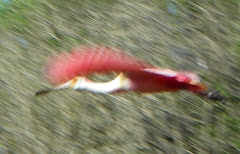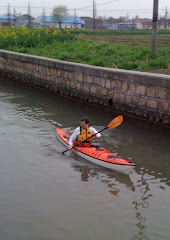My mantra is to achieve the greatest effect with the minimum
effort. I find efficiency seductive but to best achieve this I need to start
again with the basics. Efficient paddling makes use of the body’s most powerful muscle
groups to do the bulk of the work powering the kayak, with good posture ensuring
the most effective alignment for performance.
 | |||
| Good body position and blade alignment make for effective maneuvers |
I also try to maximize the traction from my paddle in the
water so I can power forward or make smooth turns without wasting energy. I want
to make my kayak move forward; I don’t want to use my energy to move water.
 |
| Edging into a turn. The blade here is in neutral |
Science can explain how a kayak moves through water, why it
might turn more easily when held at a particular angle or why different turns
can be more effective when you lean forward or back. It’s not like rocket
science, where you need a huge thrust of energy to push you into space, and
complex mathematical equations to navigate to a far off planet. Instead it’s about things like understanding how when you shift your weight a little to trim your kayak, it subtly changes the effective hull shape
in the water. Some maneuvers become more efficient with this alternative hull presentation, so you need less power to make
the same maneuver. You can fine-tune your skills more effectively if you not
only know how to do it but also why.
Basic science can explain why in some kayaks it doesn’t seem
to make any difference whether you edge
into a turn or edge away from it, both seem equally effective, while in some
other kayaks you can clearly turn more quickly when edged into a turn, or in
others most quickly when edged from a turn.
It will also explain why you can turn some kayaks more
rapidly while reversing than when you are paddling forward.
It’s a good idea to hone the effectiveness of your paddling
skills on flat water where you can focus on mastering the details even if your normal
playground is far from flat. It is easier to compare the effect of every nuance
once you eliminate the variables of wind, current and waves. With control
strokes, begin with the blade close to or in a neutral position, engaging the
blade gradually and only as much as you need.
 |
| The blade is lightly engaged for steering |
After paying attention to the details, the next phase is to
add those variables, wind, waves and current one at a time, so you can see how each
affects the moves you have practiced on the flat. Practice in wind without
waves for example. Now you’ll see how one technique for turning will become far
more effective for turning from the wind than another that works best for
turning toward the wind.
When you understand how to get the most effective
performance from your kayak in wind alone, or in waves or current alone, then
the next step is to combine them, wind and waves together, or all three.
 |
| Work on your efficiency in different conditions |
Your paddling can become smooth, efficient and effective
without you understanding the science behind it. You can still become an artist on
the water. But if you question why one move works better than another in a
particular situation and understand the reasons behind each effect, then you’ll
be able to push your skills into new realms of efficiency. You’ll use the wind,
current and waves to your advantage instead of fighting against them.
I’ll leave you with three questions. Revisit one of them when you next paddle.
1) Can I improve the efficiency of my body movement for power?
For example, can I use my torso more and my arms less? Am I using my legs and
feet?
2) How much do I move water with my paddle, and when do I do
this most? Can I reduce this, maybe by slowing my paddle stroke a little, or by
adjusting the path of my paddle?
3) Am I working against the waves, wind, and current, or
working with? If I can identify a particular situation when I have to work
harder than I would like, can I find a way to use less effort in this
situation?
 |
| The book, The Art of Kayaking offers a lot of useful detail |
My new book The Art of Kayaking offers a lot of detail for the inquisitive paddler, explained in a way that is easy to understand. It describes in detail the basic paddle and kayak skills, and then focuses their use toward different rough-water environments. The goal is to achieve more effect with less effort. You’ll also find help for trip planning with weather, charts, buoyage and safety.
Find The Art of Kayaking at store.nigelkayaks.com, (there is a signed copy option) Or support your local bookstore, or order on-line, perhaps at Amazon or Book Depository.
Interested in joining a class to learn more on the water? Please contact me through my web-site www.nigelkayaks.com.

































2 comments:
Wow! Your blog about "The Art of Kayaking meets the Science" charms me very much. I wouldn't know that the art of kayaking is related to science before reading your blog. So, I have come to get satisfied reading your page step by step. Carry on your good posting, dear. Thanks
I liked it amazing art of kayaking. I too write about blogs on water sports and kayaking
Post a Comment